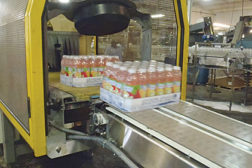Plant Focus
Processing automation helps boost blending efficiency
Read More
Lagunitas' Chicago plant allows consumers to get a peek inside the craft brewer's operations
Craft brewer already has plans to expand brewing and packaging operations
March 12, 2015
Aftermarket part advancements bring new life to beverage machinery
Part manufacturers work to educate customers about non-OEM part benefits
February 16, 2015
Efficient beverage warehouse designs key to handling SKU proliferation
New facility designs offer opportunity to accommodate future growth
December 31, 2014
Dry lubricant options help curb water use in beverage operations
Operators seek versatile lubricants to reduce needed inventories
December 16, 2014
Warehouse management systems integrate with warehouse control systems
Software integration aids supply-chain speed, accuracy and tracking
November 17, 2014
Contract manufacturers enable beverage innovation
Co-packers see rise in healthy drink requests
November 12, 2014
5 tips to maximize success with a co-packing partner
Crown offers advice on choosing a co-packer
November 12, 2014
More beverage-makers integrating robots in operations
Cost reductions, long-term ROI support increase in sales
October 16, 2014
Picking technology flexes to accommodate worker needs
Short timeframe needed to train workers on voice-picking, pick-to-light, pick-and-scan systems
October 16, 2014
Elevate your expertise in the beverage marketplace with unparalleled insights and connections.
Join thousands of beverage professionals today. Shouldn’t you know what they know?
JOIN NOW!Copyright ©2025. All Rights Reserved BNP Media.
Design, CMS, Hosting & Web Development :: ePublishing













